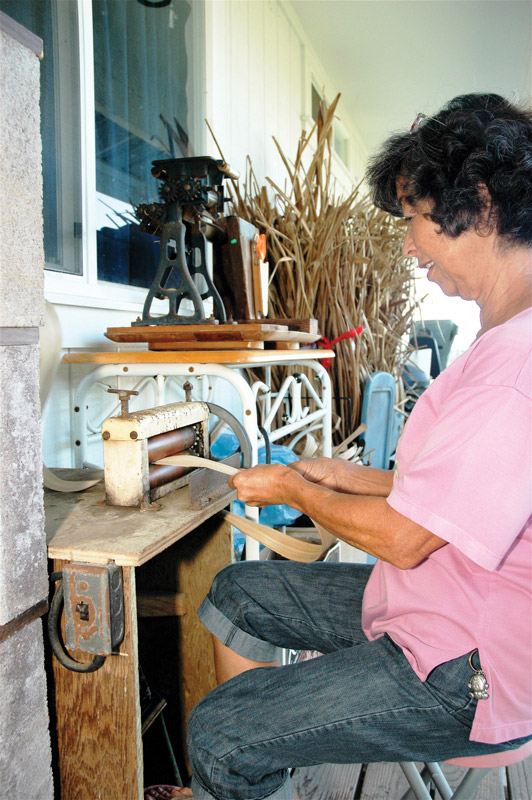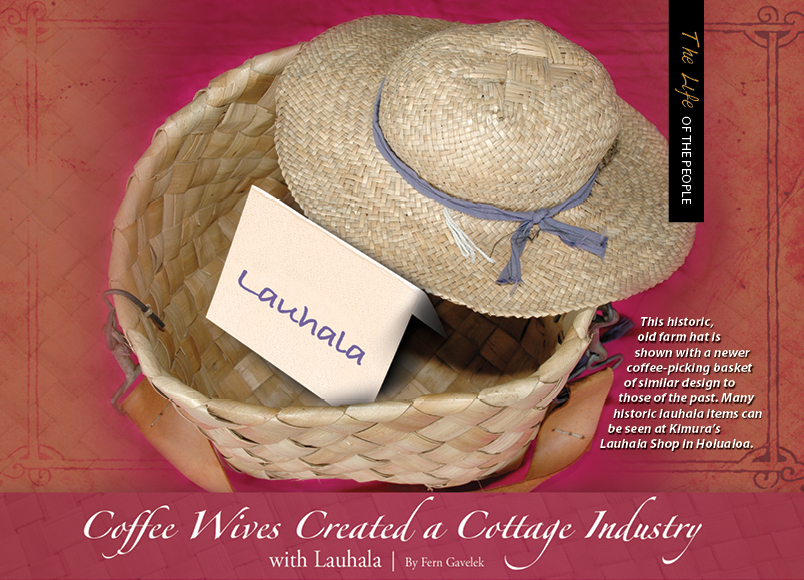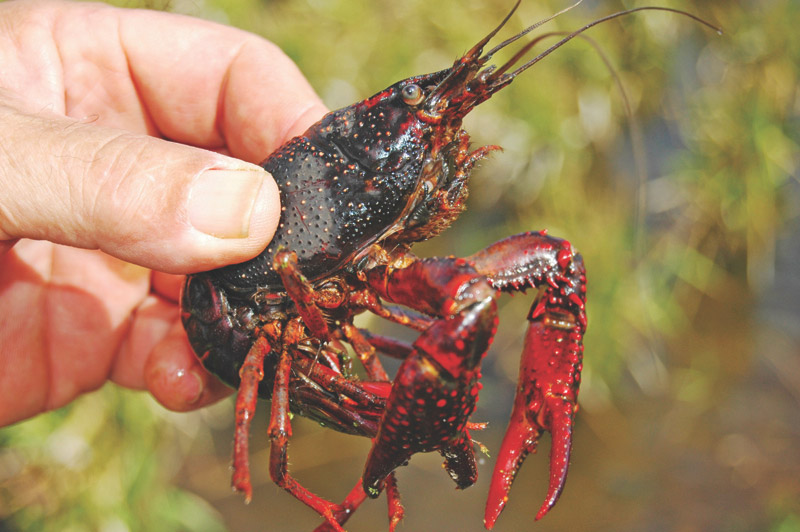
Coffee Wives Created a Cottage Industry with Lauhala

By Fern Gavelek
Times were especially tough during the 1930s Depression Era in Kona. Cash was scarce among residents of the Kona Coffee Belt along the slopes of Hualalai. To help subsidize their families between coffee seasons, Holualoa wives and mothers learned the Hawaiian art of lauhala weaving, creating a cottage industry and tradition that survives today.
They wove baskets for picking coffee, sun-shielding farm hats and large floor mats. Their efforts not only helped put food on the table, but also kept alive the intricate art of weaving objects from pandanus (hala) leaves. The lauhala staples were sold at general merchandise stores along Mamalahoa Highway and served as an important medium of exchange to purchase food and supplies.
“Grandfather and mother used to say that nobody had any money,” recalls octogenarian Alfreida Kimura Fujita, whose family owned Y. Kimura Store. “When people used lauhala to barter at our store, that’s how it came into our lives.” Located at the intersection of Mamalahoa Highway 180 and Hualalai Road, the former general merchandise store has evolved into today’s landmark, Kimura’s Lauhala Shop.
Alfreida says her mother, the late Tsuruyo Fujiwara Kimura, had a flair for creativity and during those years of hardship, became interested in lauhala weaving. She organized classes to teach local women, primarily of Asian descent, to learn weaving. Tsuruyo invited one Hawaiian woman, whom Alfreida only remembers as Mrs. Ako, “to teach the coffee wives” how to prepare lauhala and weave. The Kimuras bought the lauhala from someone in Puna, who provided the leaves in neat bundles. The Hawaiian word “lauhala” means “leaf of the hala” and refers to the pandanus leaf used for plaiting.
“Mother did it to help the wives and once they learned how to weave, they wove at home and Mother bought their items to sell in the store,” continues Alfreida. An excellent seamstress, Tsuruyo often enhanced some of the lauhala items with her own fabric lining. She also created the first lauhala tote bags. There were many good weavers involved: Mrs. Kinroe, Mrs. Tateishi, Mrs. Iwanaga, Mrs. Kusunoki, Mrs. Oka and (the late) Mrs. Tashima.
“These women supplemented their household income by weaving,” adds Alfreida. They wove year-round, working during the coffee season when it would rain.
Long-time Holualoa resident Fumie Uyeno Yoshida remembers learning how to weave lauhala as a young teen in the 1940s. She recalls a “lauhala factory” located in the house behind today’s Hualalai Garage.
“Seichi and Tomoe Sugawara owned the house and they had seven children who were put to work cleaning, rolling and stripping the lauhala,” says Fumie. A large platform in the back of the house was used for drying the leaves. There were several ladies, who have since retired from weaving, who gathered to work on a long table: Fumie’s sister, Mary Uyeno Iwanaga; plus Janet Tateishi Miyose, Doris Yokoyama Nozaki and Nancy Matsumoto Kurihara.
Wartime brought a new market for lauhala items catering to the military. The servicemen wanted gifts for their sweethearts and souvenirs. “The market then was mainly on O‘ahu as that’s where most of the men were stationed,” continues Fumie. Items were also sold to travelers staying at the Kona Hotel, which is still in operation today.
Lauhala woven in Hawai‘i is highly valued today and the craft is still taught. Gifts and useful items—cigarette and eyeglass cases, stylish purses and fashionable hats—are among the many lauhala creations.
According to Alfreida, the Japanese women also created slippers out of lauhala, filling a need that stemmed from the Japanese custom of not wearing shoes or having dirty feet inside the home. The Japanese would wipe their feet before putting on the slippers for indoor use. The sole was made of heavy fabric, cut from a pattern, and the inside of the slipper and straps were lauhala.
A diary kept by the late Clarence Yoshito Nozaki of Holualoa has entries saying he and his wife would collect lauhala for weaving in the 1940s. Holualoa resident Carol Nozaki Zakahi recalls how processing the pokey pandanus was a family affair for the Nozakis. Her mother, the late Sadame (Elaine) Taketa Nozaki, would use the leaves to weave sturdy coffee baskets and other sought-after items.
Carol explains how everyone helped: “My mom used to make us all gather the green lauhala leaves and boil them to bleach out the color. Then my brother and sisters, grandmother and aunt all pitched in to lay the leaves on the same platform that was used for drying the coffee, the hoshidana.”
The coffee hoshidana, which had a trademark roof that could be pulled over drying coffee in the event of rain, was great for drying lauhala.
Alfreida also recalls the hard work of preparing lauhala, including getting up at 4 a.m. on Saturday mornings in the 1940s to help out. However, she doesn’t remember her mother’s formula for boiling and bleaching the leaves. “Everyone had their own recipe for bleaching,” she notes. After the lauhala was dried, it was put in the “sulphur box” to deter insects.
Different homemade tools were used for softening lauhala (a hand or mechanical roller) and slicing them into desired widths (a stripper). Women would have their husbands make the tools to get the job done. That might include converting ringer washer machine rollers or udon (Japanese noodle) makers. Rudimentary strippers were nails placed into a peg at desired widths. Later blades were used to give a more refined cut. Samples of these implements, some still being used, can be seen today at Kimura’s Lauhala Shop.
While working with lauhala was hard work, Carol admits the cottage industry gave her family the opportunity to make extra money. She said everyone learned to weave small baskets, mats, fans and other, miscellaneous items.
“Between caring for us, picking coffee and cleaning houses along the shoreline of Kona, Mom eventually saved enough money to build a house in the 1980s,” Carol says with pride. “We call it the “House that Hala Built.” The family home is located on Mamalahoa Highway near the heart of Holualoa Town.
“My mom was one of several who did their lauhala weaving at home,” notes Carol. Others were the late Kimi Sakamoto Kuroyama, Mitsuko Kunitake Ohta, Sadako Sonoda Oka and Agnes and Alice Oyama.
“The items Mom wove back in the 1950s were taken down to the Hawaiian lady’s store, to Mrs. Aiu,” reminisces Carol. “This store was located on the corner of Ali‘i Drive and Hualalai Road.”
Sadame continued weaving until her later years, teaching at the senior center and participating with others when weavers would gather. Carol says she learned how to weave as a child out of necessity, but “really didn’t start to weave until 2006.” Now she enjoys weaving and makes three sizes of “Horny Honu” turtles that she sells at her beauty shop adjacent to the House that Hala Built.
“Weaving lauhala has taught me patience and grounded me to appreciate my hard-working parents and grandparents…” she muses. “I also planted some pandanus trees on our property and have one that honors my mom.”


